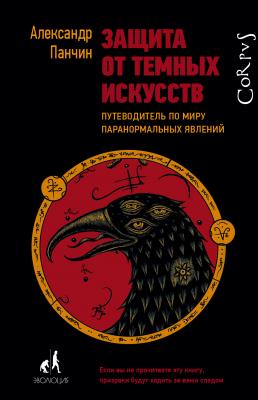Защита от темных искусств. Путеводитель по миру паранормальных явлений. Александр Панчин
Читать онлайн.| Название | Защита от темных искусств. Путеводитель по миру паранормальных явлений |
|---|---|
| Автор произведения | Александр Панчин |
| Жанр | Прочая образовательная литература |
| Серия | Библиотека фонда “Эволюция” |
| Издательство | Прочая образовательная литература |
| Год выпуска | 2018 |
| isbn | 978-5-17-982690-3 |
17
Mom fatally slashes daughter she thought was possessed by the devil. ABC News. www.religionnewsblog.com/21158/nelly-vasquez-salazar
18
What’s the harm in exorcisms? http://whatstheharm.net/exorcisms.html
19
Cheyne J. A.: Situational factors affecting sleep paralysis and associated hallucinations: position and timing effects. J Sleep Res 2002, 11 (2): 169–177.
20
Issa F. G., Sullivan C. E.: Alcohol, snoring and sleep apnea. J Neurol Neurosurg Psychiatry 1982, 45 (4): 353–359.
21
Denis D. et al.: A twin and molecular genetics study of sleep paralysis and associated factors. J Sleep Res 2015, 24 (4): 438–446.
22
McNamara P., Bulkeley K.: Dreams as a source of supernatural agent concepts. Front Psychol 2015, 6: 283.
23
Rechtschaffen A. et al.: Physiological correlates of prolonged sleep deprivation in rats. Science 1983, 221 (4606): 182–184.
Rechtschaffen A., Bergmann B. M.: Sleep deprivation in the rat by the disk-over-water method. Behav Brain Res 1995, 69 (1–2): 55–63.
24
Shaw P. J. et al.: Stress response genes protect against lethal effects of sleep deprivation in Drosophila. Nature 2002, 417 (6886): 287–291.
25
Montagna P. et al.: Familial and sporadic fatal insomnia. Lancet Neurol 2003, 2 (3): 167–176.
26
Harvey A. G., Tang N. K.: (Mis)perception of sleep in insomnia: a puzzle and a resolution. Psychol Bull 2012, 138 (1): 77–101.
27
Xie L. et al.: Sleep drives metabolite clearance from the adult brain. Science 2013, 342 (6156): 373–377.
28
Ju Y. E. et al.: Sleep and Alzheimer disease pathology – a bidirectional relationship. Nat Rev Neurol 2014, 10 (2): 115–119.
29
Ding F. et al.: Changes in the composition of brain interstitial ions control the sleep-wake cycle. Science 2016, 352 (6285): 550–555.
30
Mavromatis N. et al.: Experimental tonic hand pain modulates the corticospinal plasticity induced by a subsequent hand deafferentation. Neuroscience 2016, 330: 403–409.
31
Lotze M. et al.: Phantom movements and pain. An fMRI study in upper limb amputees. Brain 2001, 124 (Pt 11): 2268–2277.
Raffin E. et al.: Primary motor cortex changes after amputation correlate with phantom limb pain and the ability to move the phantom limb. Neuroimage 2016, 130: 134–144.
32
Flor H. et al.: Phantom limb pain: a case of maladaptive CNS plasticity? Nat Rev Neurosci 2006, 7 (11): 873–881.
33
Bostrom K. J. et al.: A computational model unifies apparently contradictory findings concerning phantom pain. Sci Rep 2014, 4: 5298.
34
Baev K. V. et al.: [Depolarization of primary afferents during fictitious scratching of thalamic cats]. Neirofiziologiia 1978, 10 (2): 173–176.
35
Ramachandran V. S.: Phantoms in the Brain: Probing the Mysteries of the Human Mind. 1999.
36
Ramachandran V. S., Rogers-Ramachandran D.: Synaesthesia in phantom limbs induced with mirrors. Proc Biol Sci 1996, 263 (1369): 377–386.
37
Kim S. Y., Kim Y. Y.: Mirror therapy for phantom limb pain. Korean J Pain 2012, 25 (4): 272–274.
Tilak M. et al.: Mirror therapy and transcutaneous electrical nerve stimulation for management of phantom limb pain in amputees – a single blinded randomized controlled trial. Physiother Res Int 2016, 21 (2): 109–115.
38
Barbin J. et al.: The effects of mirror therapy on pain and motor control of phantom limb in amputees: a systematic review. Ann Phys Rehabil Med 2016, 59 (4): 270–275.
39
Cole J. et al.: Exploratory findings with virtual reality for phantom limb pain; from stump motion to agency and analgesia. Disabil Rehabil 2009, 31 (10): 846–854.
Sano Y. et al.: Reliability of phantom pain relief in neurorehabilitation using a multimodal virtual reality system. Conf Proc IEEE Eng Med Biol Soc 2015, 2015: 2482–2485.
40
Botvinick M., Cohen J.: Rubber hands “feel” touch that eyes see. Nature 1998, 391 (6669): 756.
41
Guterstam A. et al.: Illusory ownership of an invisible body reduces autonomic and subjective social anxiety responses. Sci Rep 2015, 5: 9831.
42
Wada M. et al.: The rubber tail illusion as evidence of body ownership in mice. J Neurosci 2016, 36 (43): 11133–11137.
43
Brunner H. G. et al.: Abnormal behavior associated with a point mutation in the structural gene for monoamine oxidase A. Science 1993, 262 (5133): 578–580.
44
Caspi A. et al.: Role of genotype in the cycle of violence in maltreated children. Science 2002, 297 (5582): 851–854.
45
Shih J. C. et al.: Monoamine oxidase: from genes to behavior. Annu Rev Neurosci 1999, 22: 197–217.
Dorfman H. M. et al.: Neurobiological mechanisms for impulsive-aggression: the role of MAOA. Curr Top Behav Neurosci 2014, 17: 297–313.
46
Burnet H. et al.: Altered respiratory activity and respiratory regulations in adult monoamine oxidase A-deficient mice. J Neurosci 2001, 21 (14): 5212–5221.
47
Herraiz T. et al.: β-Carboline alkaloids in Peganum harmala and inhibition of human monoamine oxidase (MAO). Food Chem Toxicol 2010, 48 (3): 839–845.
48
Sadr Mohammadi R. et al.: Peganum harmala (Aspand) intoxication; a case report. Emerg
